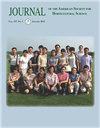榛子第2和第7连锁群上的新的简单序列重复标记及抗东方白叶枯病新源的研究
IF 1.1
4区 农林科学
Q3 HORTICULTURE
Journal of the American Society for Horticultural Science
Pub Date : 2021-05-11
DOI:10.21273/JASHS05040-21
引用次数: 5
摘要
东方榛子枯萎病(EFB)是由异头榛子引起的,是一种真菌性疾病,威胁着俄勒冈州威拉米特山谷的欧洲榛子(Corylus avellana)产业。这种病原体是美国东部的地方病,在那里它对野生美洲榛子的损害很小,但对大多数商业上重要的欧洲榛子品种会造成严重的溃疡。“Gasaway”的宿主遗传抗性是由连锁群6(LG6)上单个基因座的显性等位基因赋予的,来自其他几个来源的抗性已被定位到同一区域。一些真菌分离株可以克服“Gasaway”耐药性,促使人们寻找其他耐药性来源。来自其他来源的抗性已被定位到LG2和LG7,对于它们,额外的简单序列重复(SSR)标记将促进标记辅助选择(MAS)。在本研究中,采用电子计算机技术在LG2和LG7的EFB抗性区域开发了新的多态性SSR标记。从“Jefferson”基因组序列的17个重叠群开始,开发、表征了45个新的多态性SSR标记,并将其放在连锁图上。新的SSR标记每个位点平均有10.18个等位基因,预期杂合性、观察杂合性和多态性信息含量的平均值分别为0.72、0.65、0.68和0.068。在定位群体中分离的42个新的多态性SSR中,24个位于LG2上,12个位于LG7上,6个位于其他LGs上。使用新的和以前开发的SSR标记研究了六种新的EFB抗性来源,其中四种来自俄罗斯,两种来自克里米亚。将6个抗性选择与感病选择杂交,得到7个后代。对疾病反应的表型分析显示,两个莫斯科选择(#2和#27)、一个俄罗斯选择(OSU 1187.101)和一个克里米亚选择(H3R12P62)的后代中的分离符合预期的1:1分离比例,用于通过单基因座上的显性等位基因控制抗性;但在另一个俄罗斯选择(OSU 1166.123)和另一个克里米亚选择(H3R07P11)的后代中,抗性苗过多。SSR位点的疾病评分和等位基因的相关性表明,来自三个俄罗斯选择(莫斯科选择#2和#27以及OSU 1166.123)和克里米亚选择H3R12P62的抗性在LG7上,而来自俄罗斯选择OSU 1187.101的抗性在LG2上。克里米亚选择H3R07P11的抗性与LG6、LG2或LG7上的标记物无关。这些来源和新的SSR标记将有助于MAS和抗性基因的积累,以培育新的EFB抗性品种。本文章由计算机程序翻译,如有差异,请以英文原文为准。
New Simple Sequence Repeat Markers on Linkage Groups 2 and 7, and Investigation of New Sources of Eastern Filbert Blight Resistance in Hazelnut
Eastern filbert blight (EFB), caused by Anisogramma anomala, is a fungal disease threatening the european hazelnut (Corylus avellana) industry in the Willamette Valley of Oregon. The pathogen is endemic to the eastern United States where it causes little damage to the wild Corylus americana but causes severe cankers on most cultivars of the commercially important european hazelnut. The host genetic resistance in ‘Gasaway’ is conferred by a dominant allele at a single locus on linkage group 6 (LG6), and resistance from several other sources has been mapped to the same region. Some fungal isolates can overcome ‘Gasaway’ resistance, prompting a search for other sources of resistance. Resistance from other sources has been mapped to LG2 and LG7, for which additional simple sequence repeat (SSR) markers would facilitate marker-assisted selection (MAS). In this study, an in silico approach was used to develop new polymorphic SSR markers in the EFB resistance regions on LG2 and LG7. Starting with a search of 17 contigs of the ‘Jefferson’ genome sequence, 45 new polymorphic SSR markers were developed, characterized, and placed on the linkage map. The new SSR markers had an average of 10.18 alleles per locus, and average values for expected heterozygosity, observed heterozygosity, polymorphism information content, and frequency of null alleles of 0.72, 0.65, 0.68, and 0.068, respectively. Of the 42 new polymorphic SSRs segregating in the mapping population, 24 were on LG2, 12 were on LG7, and six were placed on other LGs. The new and previously developed SSR markers were used to study six new sources of EFB resistance, four from Russia and two from Crimea. Six resistant selections were crossed with susceptible selections, resulting in 7 progenies. Phenotyping for disease response revealed that segregation in progenies of the two Moscow selections (#2 and #27), one Russian selection (OSU 1187.101), and one Crimean selection (H3R12P62) fit the 1:1 segregation ratio expected for control of resistance by a dominant allele at a single locus; but in progenies of the other Russian selection (OSU 1166.123) and the other Crimean selection (H3R07P11), there was an excess of resistant seedlings. Correlation of disease scores and alleles at SSR loci indicated that resistance from three Russian selections (Moscow selections #2 and #27 and OSU 1166.123) and the Crimean selection H3R12P62 was on LG7, while resistance from Russian selection OSU 1187.101 was on LG2. Resistance from Crimean selection H3R07P11 was not correlated with markers on LG6, or LG2, or LG7. These sources and new SSR markers will be useful in MAS and the pyramiding of resistance genes in the breeding of new EFB-resistant cultivars.
求助全文
通过发布文献求助,成功后即可免费获取论文全文。
去求助
来源期刊
CiteScore
3.80
自引率
0.00%
发文量
31
审稿时长
2 months
期刊介绍:
The Journal of the American Society for Horticultural Science publishes papers on the results of original research on horticultural plants and their products or directly related research areas. Its prime function is to communicate mission-oriented, fundamental research to other researchers.
The journal includes detailed reports of original research results on various aspects of horticultural science and directly related subjects such as:
- Biotechnology
- Developmental Physiology
- Environmental Stress Physiology
- Genetics and Breeding
- Photosynthesis, Sources-Sink Physiology
- Postharvest Biology
- Seed Physiology
- Postharvest Biology
- Seed Physiology
- Soil-Plant-Water Relationships
- Statistics

 求助内容:
求助内容: 应助结果提醒方式:
应助结果提醒方式:


